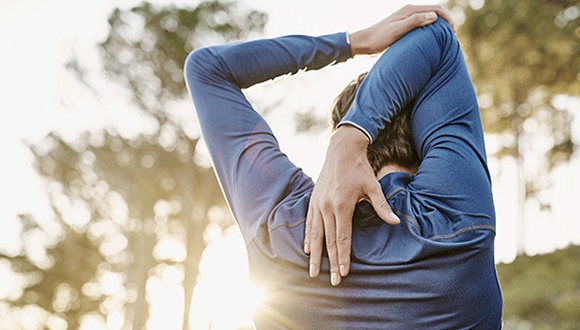Mythbusting: 6 fitness claims put to the test
We examine common claims about exercise to sort the fact from the fiction.
Stephanie Osfield
May 2018
1. Fitness claim: Cardio and weight workouts should be balanced by yoga or stretching
True. A balanced workout regime is important because it helps you exercise muscles and joints in different ways, as well as prevent a fitness plateau or injury.
“That’s why it’s important to cross-train over the week to engage in a mix of different exercises,” says Carly Ryan, exercise physiologist and standards advisor for Exercise & Sports Science Australia.
“Mix up your exercise so that it includes cardiovascular movement, [such as jogging, swimming or walking], resistance training [using free weights, weight machines, resistance bands or your own body weight] and movements that boost flexibility [yoga or stretching].”

2. Fitness claim: 10,000 steps a day are needed to benefit from walking
Partly true. More is better than less. Scottish research has shown that people who walk 15,000 steps are more protected against developing signs of metabolic syndrome, like weight gain and higher blood glucose levels.
Yet research by CARE Australia shows that the average Australian notches up only about 4,000 steps a day – less than half the recommended daily target.
The bottom line? Walk as much as you can. “Any walking is better than no walking at all,” says Ryan. If you can’t always manage 10,000 steps, then aim for as close to that target as you can.
3. Fitness claim: Running is more effective than walking for heart health and weight loss
Partly true. Though running is a more rigorous workout, brisk walking can be just as beneficial for your heart, according to research published in the Journal of the American Heart Association.
“Both walking and running are good weight bearing forms of exercise that benefit your muscles and your bones,” says Ryan. “What matters the most is which exercise motivates you to work out regularly.”
Running is more helpful for weight loss as it burns more energy, but if you set a goal of jogging every day but find it a huge chore, you’re unlikely to keep the exercise up for very long, in which case walking would be a better option. Running can also put more pressure on your joints, so it’s not for everyone.
Want to boost the weight-loss benefits of walking? Adding challenges like hills and stairs can help you burn up to 20% more kilojoules, shows research from Ohio State University.
4. Fitness claim: Yoga doesn’t help with weight loss
Partly true. “Yoga is a great mind and body activity that can help with flexibility, muscle strength and tone,” says Ryan. “Though people don’t usually do yoga to lose weight, it can still help burn a small amount of kilojoules. Interestingly, because yoga is great for toning and posture, many people say they feel slimmer just from this.”
An added bonus? Yoga may help weight loss in the long term by reducing stress. This is because stress can increase food cravings and may lead to increases in the stress hormones that can also contribute to weight gain.
5. Fitness claim: You should do resistance training every week
True. Resistance training is when your muscles try to overcome the resistance caused by lifting or pushing against a weight.
“It provides a stimulus for muscles to get stronger, work more efficiently and increase in size,” says Ryan. “It can also help with weight management. Muscle is more metabolically active, so having more lean muscle mass means your body burns more energy, even when you’re at rest. You don’t need to look like a body builder, but you should aim for 2 to 3 sessions of resistance training per week.”
Resistance training includes using weights or resistance bands and doing body weight exercises like squats and push-ups.
6. Fitness claim: You should always stretch before a workout
False. Although stretching is beneficial for flexibility, it’s not clear if it helps to do it before a workout for increased safety or performance.
“Some research suggests stretching before exercise may help reduce injury in some types of athletic performance, while other research suggests it can increase the risk of injury,” says Ryan.
While you may not feel the need to stretch, easing into your workout is a good idea.
“A warm-up should involve very light intensity movements relevant to the workout you’re about to do,” Ryan explains.
“For example, if you’re going for a brisk walk or run, start with light walking and gradually build up the intensity over a 5 to 10 minute period.”
After you exercise is actually a great time to stretch to maintain your flexibility, as your muscles are warmed up.
Related articles
6 COMMON DIET MYTHS, BUSTED
When it comes to diet and nutrition, there are plenty of misconceptions out there. We sort fact from fiction to help you stay on track.
IS RUNNING GOOD FOR YOU?
Depending on who you ask, running will either add years to your life or age you prematurely. Here are the facts.
WHAT KIND OF EXERCISER ARE YOU?
From people player to weekend warrior, find the key to enjoying your workouts and sticking at them.
WHICH CARDIO IS RIGHT FOR YOU: STEADY STATE OR HIIT?
Longer sessions at a moderate pace or less time but much more intensity? We compare the differences between these cardio workouts.